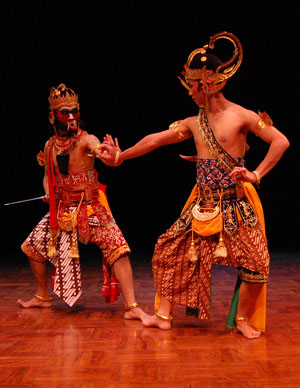Top Qs
Timeline
Chat
Perspective
Bambangan Cakil
Indonesian classical dance From Wikipedia, the free encyclopedia
Remove ads
Bambangan Cakil (Javanese: ꧋ꦧꦩ꧀ꦧꦔꦤ꧀ꦕꦏꦶꦭ꧀) is a classical dance-drama[1] of the Javanese people in—particularly—Central Java, Indonesia.[2] This dance-drama demonstrates wayang performance due to the movement is adopted from one of the scenes in wayang kulit performance, that is the Perang Kembang scene.[3] The Perang Kembang told about war between kesatria and raksasa. The kesatria has soft and gentle characters, while the raksasa is described as a character who is rough and violent.

The dance-drama war[4] between kesatria (Bambangan) against raksasa (Cakil) could also be used as a place for a dalang's judgment in moving a puppet.
Remove ads
Philosophy
In Javanese culture, kesatria are always considered to be good figures, willing to defend the truth, to help others, etc.[5] The kesatria title is given, rather than being heredity. For example, in the Mahabharata story, Kurawa does not have a kesatria title, even though he has the same ancestors as the Pandava.
On the other hand, raksasa are characterised as rough, violent and dynamic.
Characterizations
In the Bambangan Cakil dance-drama, Arjuna is depicted as kesatria, while Cakil is depicted as raksasa.[6]
See also
References
External links
Wikiwand - on
Seamless Wikipedia browsing. On steroids.
Remove ads

